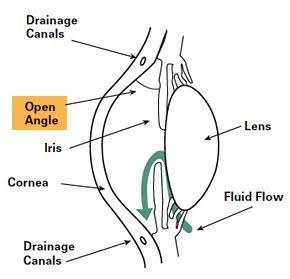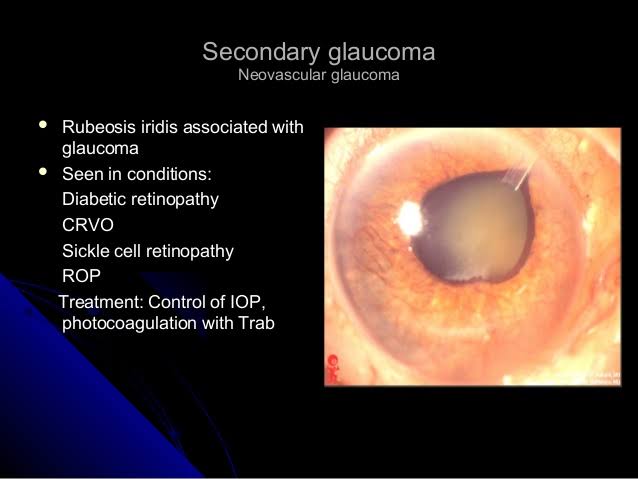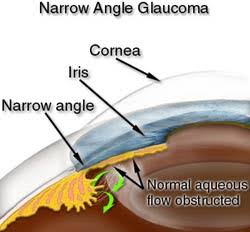UNDERSTANDING GLAUCOMA
Glaucoma is a group of disease that gradually steals sight without warning and often without symptoms, it is a condition in which normal fluid pressure inside the eyes (intraocular pressure, or lOP) slowly raises, when the aqueous humor which normally flows in and out of the eye cannot drain properly instead, the fluid collects and causes pressure damage to the optic nerve (a bundle of more than 1million nerve fibres that connect the retina with the brain) with subsequent loss of vision. There are sub-types of Primary glaucoma: Open Angle, Narrow Angle, and Congenital Glaucoma.
.jpg)
OPEN ANGLE (CHRONIC) GLAUCOMA
This is the most common form of glaucoma. This happens when the aqueous fluid drainage canals (canal of Schlemm) become constrictive or obstructed over time. The inner eye pressure (intraocular pressure or lOP) rises because the correct amount of fluid cannot drain out of the eye. With open angle glaucoma, the entrances to the drainage canals are clear and should be working correctly, It has a genetic basis. There is sclerosis of the trabecular meshwork in any type of eye. The endothelial lining of the canal of schlemm may also be sclerosed.
INCIDENCE
Age; It affects 6-7th decade mainly.
Sex; Both sexes are involved equally.
MECHANISM OF OPEN ANGLE GLAUCOMA
There is increased resistance of the outflow of the aqueous humor offered by:
The sclerosed trabecular meshwork Electron microscopic pictures shows following changes in the trabecular meshwork
.jpg)
- Proliferation of endothelial lining with thickening of the basement membrane.
- Narrowing of inter-trabecular space.
- Deposition of amorphous material in the juxstacanaliular tissue.
- The sclerosed endothelium lining of the canal of schlemm .This leads to narrowing or collapse of canal of schlemm.
SYMPTOMS
- There's painless progressive loss of vision. Due to it's insidious onset, it is usually noticed when vision is completely lost in one eye and the other is seriously impaired.
- Mild headache and eye ache may be present.
- A defect in the visual field noticed by an intelligent patient is often present
- Light sense is defective. Light minimum is raised and dark adaptation is slowed .
- Cloudy vision etc.
SIGNS
- Visual acuity decreases gradually; However, it remains good till the late stage as the central field if vision persists .
- Cornea is usually clear.
- Anterior chamber depth and angle are normal.
- Pupillary reactions remain normal until the Late stage when they become sluggish.
DIAGNOSIS
- Raised intraocular pressure: Raise tensions in open angle glaucoma careful study and repeated observations of tension are required.
Initially there is exaggeration of normal diurnal variation. A variation of intraocular pressure over 5mmHg (SCHIOTZ) should always excite suspicion of glaucoma, later on there is permanent elevation of tension so that the normal basal level is now attained. - Cupping of the optic disc pathogenesis of optic disc changes both mechanical and vascular factors play a role in the cupping of the disc.
- Visual field defects.
NARROW ANGLE
Narrow angle glaucoma is also known as closed angle glaucoma. It is much more rare and different from open angle glaucoma. Eye pressure usually goes up very fast this happens when the drainage canals gets blocked or covered. The angle between the iris and the cornea is not as wide and open as it should be. Outer edge of the Iris bunch up over the drainage canal when the pupil enlarges too much or too quickly.
STAGE OF CHRONIC NARROW ANGLE GLAUCOMA
- There is diminution of vision associated with eye ache and headache .
- The eye is irritable and the visual acuity to always impaired.
- Circumcorneal ciliary congestion is present around the limbus as reddish blue zone.
SYMPTOMS
Painful blindness
Eye with no perception of light (no PL) is the most prominent symptoms.
SIGNS
- There is deep cupping of the optic disc.
- The pupil is grey instead of jet black, dilated and vertically oval.
- Ciliary congestion is present around the limbus .
- Anterior chamber is very shallow.
CONGENITAL GLAUCOMA
Congenital Glaucoma is a rare form of glaucoma that occurs in babies and young children. This condition can be inherited. It is usually the result of incorrect or incomplete development of the eye's drainage canals during the prenatal period.
SECONDARY GLAUCOMA
.jpg)
Secondary glaucoma occurs due to a specific anomaly or disease of the eye. It also occur to any form of glaucoma in which there is an identifiable cause of increased eye pressure, resulting in optic nerve damage and vision loss.
As with primary glaucoma secondary glaucoma can be of open angle or angle closure type and it can occur in one or both eyes.
Secondary glaucoma may be caused by an eye injury, inflammation, certain drugs such as steroids and advanced cases of cataract or diabetes.
The type of treatment will depend on the underlying causes, but usually includes;
-Medicine.
-Laser.
-Surgery or conventional surgery.
EXFOLIATIVE GLAUCOMA
Occurs when a flaxy, dandruff like material peels off the outer layer of the late stage when they become within the eye. The material collects in the angle between the cornea and iris and can clog the drainage system of the eye, causing eye pressure to rise .
PSEUDOEXFLOLIATIVE GLAUCOMA
NEOVASCULAR GLAUCOMA
This is caused by the abnormal formation of new blood vessels on the iris and over the eyes drainage channels. Neovascular glaucoma is always associated with other abnormalities, most often diabetes. It never occurs on its own. The new blood vessels block the eyes fluid from exiting through the trabecular meshwork (the eye's drainage canals). Causing an increase in the eye pressure etc.
The only current treatment for glaucoma is to lower intraocular pressure (IOP), which cab be achieved with eyedrops, laser, Or incisional surgery .
Eye drops are the most common treatment modality and over time , patients may need to take multiple type's of eye drops in order to stop progression of a disease that typically has no symptoms.
To be at the safe side get to any eye hospital and make sure you get your eyes checked.
.jpg)
.jpg)
There are lots of diseases that can certainly affect us as a whole. This might be a stupid question but is glaucoma hereditary?
Yes it is dear, but not all.@leeart
Congratulations @merciboku! You have completed some achievement on Steemit and have been rewarded with new badge(s) :
Click on any badge to view your own Board of Honor on SteemitBoard.
For more information about SteemitBoard, click here
If you no longer want to receive notifications, reply to this comment with the word
STOP